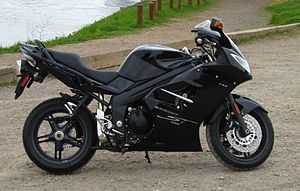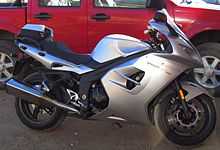Triumph Sprint ST
 | |
| Manufacturer | Triumph |
|---|---|
| Production | since 1998 |
| Predecessor | Sprint 900 |
| Class | Sport touring bike |
| Engine | 1,050 cc Triple |
| Bore / stroke | 79.0 mm × 71.4 mm (3.11 in × 2.81 in) |
| Power | 125 PS (92 kW) @ 9,100 rpm |
| Torque | 103 N·m (76 lbf·ft) @ 7,500 rpm |
| Transmission | 6-speed |
| Frame type | Aluminium beam perimeter |
| Suspension |
Front: Showa 43 mm cartridge forks with dual rate springs and adjustable preload 127 mm travel Rear: Showa monoshock with adjustable preload and rebound damping, 119 mm travel |
| Brakes |
Front Brakes: Twin 320 mm floating discs, Nissin 4 piston callipers (ABS model available) |
| Dimensions |
W: 750 mm (30 in) |
| Seat height | 805 mm (31.7 in) |
| Weight |
210 kg (460 lb) ABS model: 213 kg (470 lb) (dry) 241 kg (531 lb) (wet) |
| Fuel capacity | 20 L (4.4 imp gal; 5.3 US gal) |
The Triumph Sprint ST is a sport touring motorcycle manufactured in the United Kingdom since 1999 by Triumph.
Generations
955 cc (T596)
The Sprint ST was first introduced in 1999 as a complete redesign of the earlier Sprint 900 (1993–1998) styled by Rod Scivyer. It made use of a 955 cc straight-three engine similar to those found in the contemporaneous Speed Triple and Daytona models, only slightly retuned for smoother power delivery. Power was claimed to be 72 kW for early models 1998-2000, later 105 bhp (78 kW).
The model's appearance remained mostly unchanged from its introduction in 1999. An engine revamp with the assistance of Lotus in 2002 increased output to 118 bhp (88 kW) at 9100rpm and 100 N·m (74 lbf·ft) of torque at 5100rpm from a lighter engine—the bike is 207 kg (456 lb) dry.
1,050 cc
In 2005, Triumph introduced a redesigned Sprint ST based around the same inline triple, increased in stroke to yield a displacement of 1,050 cc (64 cu in) and with a new fuel injection system. The update to the engine modestly increased the power (123 hp / 90 Kw @ 9250 rpm) and torque (104 Nm / 77 ft-lb @ 5000 rpm) compared to the 2002 version of the 955i engine. The 1050 ST redesigned chassis found its wheelbase shortened, the instrument cluster was modernised with miles-per-gallon and miles-to-empty displays, exhaust pipes were tucked under the seat, the headlights were completely redesigned and LED tail-lights added, and a host of modern options including pannier mounts and anti-lock brakes (ABS 2006 onwards) became available.
For the remainder of its model life (when it was replaced by the Sprint GT in 2010) the engine and frame / chassis configuration remained unchanged. Some modifications were made to the standard trim of the bike for the 2007 model year (colour-matched panniers, handlebar risers and an improved windscreen), and in 2008 the original composite fuel tank was replaced by a steel fuel tank of the same size / shape to allow the use of magnetic tank bags. Also in 2008 a new headlamp design and new footrest designs (with more durable rubber) were introduced.

For 2010, the Triumph Sprint GT was launched.[1] The GT (Grand Tourer) featured a revised version of the 1050 triple engine with slightly more power (128 hp / 96 kW @ 9200 rpm) and torque (108 Nm / 80 ft-lb @ 6300 rpm) though the peak torque was produced at significantly higher revs than before. The power changes were as a result of use of an uprated ECU, the elimination of the 1050 ST's signature triple under seat exhaust in favour of a side-mounted 3-into-1 exhaust, and a revised throttle body intake. The highest gear was made seven percent taller than the ST to allowing for more relaxed highway cruising, giving an engine speed at a steady 110 km/h (68 MPH) of just over 4,000 rpm. The GT chassis was slightly longer than the ST, with an overall length of 2260mm (89.0 inches) compared to the ST with 2114mm (83.2 inches) and a wheelbase for the GT of 1537mm (60.5 inches) compared to the ST at a smaller 1457mm (57.4 inches). Suspension components were also changed, the front forks containing all new internal spring rates and rear suspension featuring spring preload and rebound damping adjustability, the former being with a twist knob rather than adjustable with a flat-head screwdriver - front and rear suspension units were supplied by Showa. These new additions added just over 7 kg (15 lb) to the weight of the bike, fully fuelled, with a total ready-to-ride weight, from the factory of 265 kg (584 lb). The GT retained the 2008 ST headlamp design, and included anti-lock brakes (ABS) that had been optional on the ST 1050. The longer chassis allowed pillion footpegs to be repositioned and the seat reshaped to be more accommodating for carrying a passenger, and the use of a new design of hard panniers that were significantly larger than those available on the ST 1050 (31 litres each side vs. 22 litres each side on the ST 1050) were supplied as a standard fitting, with an optional 55 litre top box able to be obtained as a factory accessory.
Although a number of minor model changes have occurred (most notably the introduction of the Special Edition - which included some previously optional accessories such as Gel Seat as standard) the model has not changed since 2010.
References
External links
- Triumph Web Site
- Motorcyclist 2005 Sprint ST Review
- Motorcycle.com 1999 Sprint ST Review
- 2002-04 Sprint ST - 10's of Links.
- Motorcycle-USA's 2007 Triumph Sprint ST Review
| ||||||||||||||